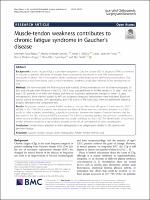Por favor, use este identificador para citar o enlazar este ítem:
https://repositorio.usj.es/handle/123456789/293
Registro completo de metadatos
| Campo DC | Valor | Lengua/Idioma |
|---|---|---|
| dc.contributor.author | Roca-Espiaú, Mercedes | - |
| dc.contributor.author | Andrade-Campos, Marcio | - |
| dc.contributor.author | Cebolla, Jorge Javier | - |
| dc.contributor.author | López de Frutos, Laura | - |
| dc.contributor.author | Medrano-Engay, Blanca | - |
| dc.contributor.author | López-Royo, María Pilar | - |
| dc.contributor.author | Giraldo, Pilar | - |
| dc.date.accessioned | 2020-01-15T11:37:30Z | - |
| dc.date.available | 2020-01-15T11:37:30Z | - |
| dc.date.issued | 2019-11-21 | - |
| dc.identifier.citation | Roca-Espiau, M., Andrade-Campos, M., Cebolla, J.J. et al. Muscle-tendon weakness contributes to chronic fatigue syndrome in Gaucher’s disease. J Orthop Surg Res 14, 383 (2019) doi:10.1186/s13018-019-1452-y | es_ES |
| dc.identifier.issn | 1749-799X | es_ES |
| dc.identifier.uri | https://repositorio.usj.es/handle/123456789/293 | - |
| dc.description.abstract | BACKGROUND: Chronic fatigue (CFg) is a prevalent symptom in Gaucher disease (GD) at diagnosis (79%) and remains in a quarter of patients after years of therapy. Bone abnormalities are present in over 70% and peripheral neuropathy in about 11% of the patients, which contributes to the disabling and debilitating complications. Our hypothesis is that other factors such as muscle-tendinous weakness could have influence in the development of CFg. METHODS: We have evaluated the fiber structure and elasticity of muscle-tendinous unit by strain-elastography (S-ELA) and analyzed their influence in the CFg. S-ELA study was performed in Achilles tendon in 25 type 1 and two type 3 GD patients, all of them with fatigue and were on enzymatic replacement therapy for mean 13years; simultaneously, bone marrow burden by MRI and calcaneus ultrasound densitometry were evaluated. Blood cell counts, plasma biomarkers, GBA1 genotyping, and SF36 quality of life scale (QoL) were also performed. STATISTICAL ANALYSIS: descriptive and comparative test. RESULTS: All patients showed a normal Achilles tendinous structure. Abnormal stiff grade 2-3 was found in 17/27 (62.9%); in 11/27 (40.7%) of patients, the alteration was bilateral. There were no correlations between the S-ELA results to other variables; nevertheless, a significant correlation between the degree of tendon hardness and the low score on the QoL scales (p=0.0035) was found. The S-ELA is a sensitive painless, fast, and low cost method to detect muscle-tendinous subclinical dysfunction that could contribute to CFg in GD. The identification of subclinical tendon alteration would be a sign of alarm, focused on the risk of development of bone complications. CONCLUSION: Intratendinous alteration in strain-elastography is an independent variable in GD patients with persistent fatigue. | es_ES |
| dc.format.extent | 8 p. | es_ES |
| dc.format.mimetype | application/pdf | es_ES |
| dc.language.iso | eng | es_ES |
| dc.publisher | BMC | es_ES |
| dc.relation | 03-2018 FEETEG | es_ES |
| dc.relation.requires | Adobe PDF | es_ES |
| dc.rights | Attribution-NonCommercial-NoDerivatives 4.0 Internacional | * |
| dc.rights.uri | http://creativecommons.org/licenses/by-nc-nd/4.0/ | * |
| dc.subject | Achilles tendon stiffness | es_ES |
| dc.subject | Fatigue | es_ES |
| dc.subject | Gaucher disease | es_ES |
| dc.subject | QoL | es_ES |
| dc.subject | Strain-elastography | es_ES |
| dc.title | Muscle-tendon weakness contributes to chronic fatigue syndrome in Gaucher's disease. | es_ES |
| dc.type | journal article | es_ES |
| dc.subject.unesco | Fibra | es_ES |
| dc.relation.publisherversion | https://josr-online.biomedcentral.com/articles/10.1186/s13018-019-1452-y | es_ES |
| dc.identifier.doi | https://doi.org/10.1186/s13018-019-1452-y | es_ES |
| dc.rights.accessRights | open access | es_ES |
| Aparece en las colecciones: | Artículos de revistas | |
Ficheros en este ítem:
| Fichero | Descripción | Tamaño | Formato | |
|---|---|---|---|---|
| s13018-019-1452-y.pdf | 2,21 MB | Adobe PDF |  Visualizar/Abrir |
Este ítem está sujeto a una licencia Creative Commons Licencia Creative Commons

